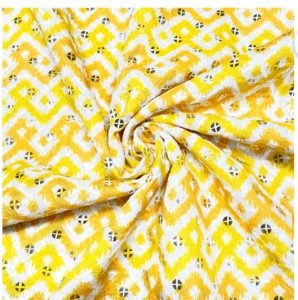Blended Cotton Fabric in the Fashion Industry: Trends and Innovations
Introduction
The fashion industry is constantly evolving as designers and producers look for new materials to make eco-friendly, cosy, and fashionable apparel. One such material that has gained significant attention in recent years is blended cotton fabric. Blended cotton combines the natural properties of cotton with other fibers, resulting in a versatile fabric that offers numerous advantages. In this article, we will delve into the latest trends and innovations surrounding blended cotton fabric in the fashion industry.
Understanding Blended Cotton Fabric
Blended cotton fabric is an exciting combination of cotton and other fibers, such as polyester, rayon, or spandex. This unique blend brings together the best qualities of each fiber, resulting in a fabric that surpasses expectations in both performance and aesthetics. By blending cotton with synthetic fibers, designers have unlocked a world of possibilities, enhancing the fabric’s durability, elasticity, and wrinkle resistance while preserving the breathability and softness that cotton is renowned for.
The Advantages of Blended Cotton Fabric
Enhanced Durability and Performance
Blending cotton with synthetic fibers significantly improves the fabric’s durability and performance. The addition of fibers like polyester or nylon makes the fabric more resistant to wear and tear, ensuring that clothing made from blended cotton lasts longer. This durability is particularly advantageous for activewear, sportswear, and outdoor clothing, where garments need to withstand rigorous use.
Increased Comfort and Breathability
Despite the addition of synthetic fibers, blended cotton fabric retains its inherent breathability and comfort. The natural fibers in cotton allow air to circulate, keeping the wearer cool and comfortable. Blended cotton also wicks away moisture, making it an excellent choice for clothing that needs to remain dry, such as athletic wear or summer garments.
Improved Fit and Shape Retention
Blending cotton with fibers like spandex or elastane enhances the fabric’s elasticity and stretchability. This results in improved fit and shape retention, allowing clothing made from blended cotton to hug the body and maintain its form even after multiple washes. The added stretch also increases flexibility, making blended cotton ideal for garments that require freedom of movement.

Sustainable Fashion and Blended Cotton
Eco-Friendly Production
Blended cotton fabric offers sustainability advantages compared to purely synthetic fabrics. Cotton is a renewable resource, and blending it with synthetic fibers reduces the reliance on non-renewable resources. Additionally, the production of blended cotton often requires less water and energy compared to synthetic fabrics, making it a more environmentally friendly choice.
Versatility in Sustainable Fashion
As sustainability becomes a priority in the fashion industry, blended cotton fabric provides designers with a versatile material for creating sustainable clothing. Blended cotton can be used to make a wide range of garments, including t-shirts, dresses, jeans, and athleisure wear, catering to different consumer preferences. By incorporating blended cotton into their collections, designers can offer eco-conscious consumers fashionable choices that align with their values.
Innovations in Blended Cotton Fabric
High-Tech Blends
The fashion industry is witnessing the emergence of high-tech blends that combine cotton with advanced fibers, such as conductive materials or performance-enhancing additives. These innovative blends enable the creation of clothing with built-in technology, such as moisture-wicking properties, UV protection, or even embedded sensors. High-tech blended cotton fabric opens up exciting possibilities for functional and interactive fashion.
Sustainable Dyeing and Finishing Techniques
Another area of innovation in blended cotton fabric is sustainable dyeing and finishing techniques. Traditional textile dyeing and finishing processes often involve the use of harmful chemicals and excessive water consumption, contributing to environmental pollution. However, advancements in sustainable dyeing methods, such as natural dyeing and low-impact dyeing, are being applied to blended cotton fabric. These techniques reduce the environmental impact by using natural and eco-friendly dyes, minimizing water usage, and ensuring proper waste management.
Blended Cotton with Recycled Fibers
In line with the fashion industry’s growing emphasis on sustainability, designers are exploring the incorporation of recycled fibers in blended cotton fabric. By blending cotton with recycled polyester or other recycled materials, clothing manufacturers can reduce their reliance on virgin materials and contribute to the circular economy. This approach not only minimizes waste but also reduces the carbon footprint associated with fabric production.
Blended Cotton Fabric in Fashion Trends
Athleisure and Activewear
Blended cotton fabric has made significant inroads into the athleisure and activewear sectors. The combination of cotton’s softness and breathability with the performance-enhancing properties of synthetic fibers creates the ideal fabric for comfortable and functional workout clothing. Athleisure brands are utilizing blended cotton to design leggings, sports bras, and t-shirts that offer both style and performance.
Sustainable Denim
Denim, a staple in the fashion industry, has also seen the integration of blended cotton fabric. Sustainable denim brands are using blended cotton to create eco-friendly jeans that are both fashionable and durable. Blended cotton enhances the denim’s strength, stretch, and shape retention, ensuring a long-lasting and comfortable fit.
Everyday Apparel
Blended cotton fabric has become popular in everyday apparel, ranging from casual t-shirts and dresses to workwear. The versatility of blended cotton allows designers to create garments that are suitable for various occasions, offering a balance between comfort, style, and sustainability. Consumers are increasingly drawn to blended cotton clothing due to its breathable nature, easy care, and longevity.
Conclusion
Blended cotton fabric has emerged as a versatile and sustainable material in the fashion industry, offering numerous advantages over traditional fabrics. With enhanced durability, comfort, and performance, blended cotton caters to the demands of modern consumers who seek stylish and eco-conscious clothing options. The innovations in blended cotton, such as high-tech blends and sustainable dyeing techniques, further propel its adoption in the industry.
https://www.tradeuno.com/collections/buy-cotton-lace-fabric







